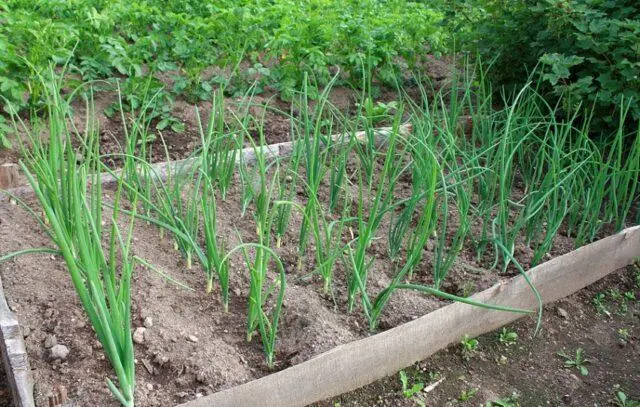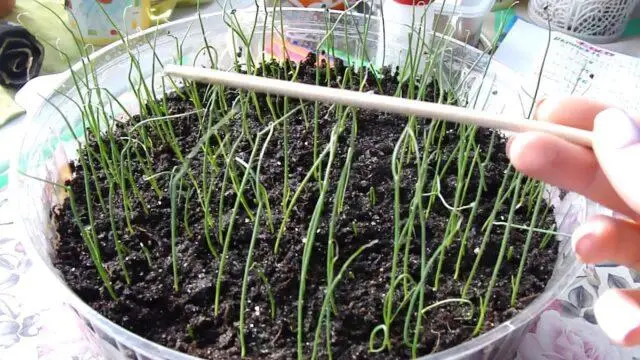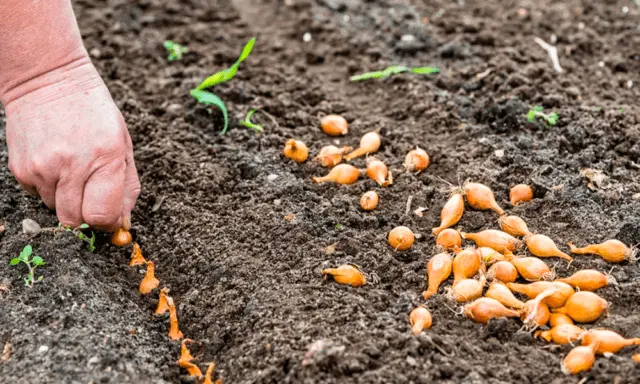Contents
The Corrado F1 onion is a first generation hybrid that is in demand by buyers and farmers. The plant is universal: bulbs and herbs are used both fresh and added to soups, in winter preparations.
Origin of the variety
Onion Corrado was bred on the basis of the Dutch seed company Nickerson Zwaan BV. In 2015, it was included in the State Register of Breeding Achievements of Our Country. Approved for cultivation in the Central, East Siberian, Nizhnevolzhsky, North Caucasian and Far Eastern regions.
Description and characteristics of onions of the Corrado variety
Corrado F1 onion sets are high-yielding varieties. It is a hybrid that is resistant to many diseases and pests. It has a lot of advantages, so it is grown not only for personal purposes, but also for further sale.
Appearance

Bow Corrado has a powerful structure
The heads are leveled, rounded, have two rudiments. The average weight is 100-110 g. The leaves are dark green, glossy, it seems that they are covered with a wax coating. The feathers are well developed. The bulbous neck is of medium thickness, but it can also be thin.
The color of Corrado onion heads ranges from yellow to golden brown, with a gray tinge may be present. According to consumer reviews, the taste is pleasant, with an average sharpness.
Ripening time and yield
When grown in the Moscow region, the average yield of turnip was 33,2 tons per hectare. The maximum indicator is 60,9 t/ha.
The yield of Corrado onions is influenced by the weather conditions of the region, the quality of the soil and the correct care.
The hybrid variety belongs to medium (mid-season) crops. Onions reach technical ripeness in 75-95 days after the appearance of the first shoots.
Disease and pest resistance
The Corrado variety is a hybrid, therefore it is highly resistant to diseases and pests. Subject to the requirements for planting and agricultural technology, there are no problems with growing a healthy crop. Occasionally, novice gardeners complain that the tops of the Corrado variety are fading. This means that the plant lacks nitrogen fertilizers. To fix the problem, you need to feed the onion with urea. 20 g of the substance is dissolved in 10 liters of water and the area is watered.
Another problem that vegetable growers face is leaf curl. This symptom indicates a lack of potassium in the soil. To solve the problem, 10 g of potassium salt is diluted in a bucket of water.
Composition and Properties
Corrado bulbs contain:
- sugar (fructose, maltose, sucrose) – from 9 to 13%;
- proteins – 1,5-2%;
- vitamin C;
- potassium;
- phosphorus;
- iron;
- phytoncides;
- quercetin flavonoid;
- saponins.
Green onion shoots are also good for the body. They contain: ascorbic, malic acids, sugars, proteins, essential oils, pectins, glycosides.
The healing properties of onions have long been recognized by all the peoples of the world. The sap of the plant is a natural antibiotic. It is effective in the treatment of bronchitis and other diseases of the upper respiratory tract. Onion juice is able to kill various types of microbes (streptococci, dysentery, diphtheria and tuberculosis bacilli).

Vitamin C, contained in the heads and green shoots, is necessary for beriberi and reduced immunity.
The leaves are used to improve skin color. An onion cut in half will help remove freckles. To do this, it is enough to wipe the problem areas of the skin once a day.
Onion burns fat well, so it is included in the diet.
Where to use
Corrado onions are used in cooking. It is added to food both fresh and fried, boiled, steamed. Vegetable salads are prepared with onions.

Fresh onions are added to canned mushrooms and sauerkraut
Crushed heads are fried, added to soups, borscht, gravies, sauces. Onions are introduced into minced meat for cutlets. Even pies are prepared with this ingredient. Salads, first and second courses are decorated with greens.
In addition to cooking, onions have found their use in medicine. The use of this vegetable promotes the release of digestive juices. Onion has a bactericidal, diuretic, sedative effect. With regular use of fresh onions, the excretory function of the kidneys is restored.
Advantages and disadvantages
The hybrid variety Corrado has many advantages. But before planting it, it is necessary to study the shortcomings and evaluate the merits.

The main plus of the Corrado variety is resistance to crop diseases.
Advantages:
- high yield;
- suitable for growing greens;
- long-term storage;
- rarely suffers from diseases and pests;
- can be transported over long distances.
Disadvantages:
- instability to cooling, therefore, it is recommended to grow in the southern regions or in central Our Country;
- with heavy watering or excessive rainfall, rotting of the bulbs is possible;
- inability to obtain planting material from seeds collected from the site;
- high cost of seeding.
Methods for planting Corrado onions
It is possible to collect a high yield only from high-quality material. To get a Corrado onion turnip in the Southern regions and the Middle lane in one season, you can use winter or early spring sowing, as well as seedlings.
In colder regions, sevok is first obtained from seeds. Only for the next season they harvest turnips.
Cultivation from seeds
Seeds are sown at the end of April in open ground (in regions with a warm climate). They are pre-soaked in warm water or in a growth stimulator for 1-2 days.
The most commonly used method of landing. 20 cm is maintained between the tapes. Planting depth is 1-2 cm. After the emergence of seedlings, the beds are thinned out, maintaining an interval of 2 cm between adjacent specimens. When three true leaves appear on the onion, a second procedure is carried out. There should be a distance of 6 cm between adjacent plants.
If the seeds are planted before winter, then the best period is the end of October – the beginning of November. In this case, the seeding rate is increased three times. Landings must be mulched with a thick layer of peat. This method is good because shoots appear much earlier, so the bulbs ripen faster.

To get seedlings, Corrado seeds are sown in containers in a heated room in early March.
Seedlings are transferred to open ground in 50-60 days. By this time, seedlings should have 3-4 true leaves. The transplant is carried out on a cloudy day. Between rows maintain a distance of 25 cm, and between adjacent shoots – 6-8 cm.
Planting seedlings in open ground
Seeds of Corrado are planted in open ground after the threat of frost has passed. Shallow furrows are formed on the bed. There should be at least 20 cm between them. The soil is carefully watered, wood ash mixed with sand is added.
The sevok is buried in the ground and sprinkled so that there is a 2 cm layer on top.

With a shallow planting, the Corrado onion gives early shoots, but in this case it will not be possible to grow a large turnip
6-8 cm are left between adjacent bulbs. This distance is necessary for the full formation of the turnip. Some gardeners in small beds use a serpentine planting. In this case, the Corrado sets are placed more densely. With this cultivation, thinning is required. When shoots appear, every second bulb is pulled out of the garden along with the feather. This method allows you to collect greens and grow a large turnip.
Onion care Corrado
The crop yield directly depends on proper care.

Onion Corrado needs timely watering
The frequency of humidification depends on weather conditions. Usually, one watering per week is enough for a crop. In case of severe drought and lack of rain, the beds are moistened 2-3 times.
The introduction of dressings allows you to increase the yield of the Corrado variety. The procedure is carried out three times per season. Nitrogen compounds are needed to build greenery. They are used two weeks after the appearance of the first shoots of Corrado onions. A month later, nitrophoska is suitable as a top dressing. During the formation of bulbs, it is recommended to use superphosphate, ash.
Conclusion
Onion Corrado is a hybrid that is used for growing on a turnip and on a feather. The variety is productive, resistant to major diseases and pests of the crop. Long shelf life allows onions to be used all winter.









